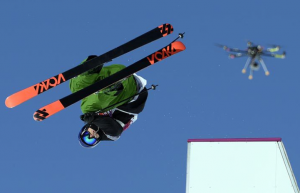 Color me impressed…the coverage of the Sochi 2014 Olympics from a photographic and video analysis perspective is amazing. Each event’s techniques come alive when shown through multiple exposure and virtual comparison. We’ve come a very long way from the coverage of the Vancouver Games just four years ago.
Color me impressed…the coverage of the Sochi 2014 Olympics from a photographic and video analysis perspective is amazing. Each event’s techniques come alive when shown through multiple exposure and virtual comparison. We’ve come a very long way from the coverage of the Vancouver Games just four years ago.
With this Winter Olympics, we’re inside the smallest detail of each skater, skier and skeleton rider like never before and it is remarkable. Making it work involves technology that can best be called imaging Big Data. Using fully digitized images without or outside of the cameras themselves is giving us insights we’ve never had before.
Drone imaging
It isn’t just new ways of capturing — it’s new places to capture from, like the use of drone cameras that whir silently above the competition. If you think drones are only a part of expensive coverage, think again. They’re starting to become the norm in events both international and local.

We ran a 5K in Maui this weekend that was monitored at the start and finish by a drone with a sizeable camera hanging below. These machines are known as “hexacopters” for their six rotors and can stay aloft as long as 40 minutes, which is much cheaper and more flexible than a helicopter. Drones are programed to return to base at the first sign of low batteries, poor flying conditions or a malfunction, making them even safer and less distracting above a crowd than a noisy, expensive helicopter.
A Ladies Super G disaster
But what really caught our attention in the Sochi Olympic coverage was the use of video playback superimposition that showed multiple competitors in the Ladies Super G at the same moment of the timeclock for each’s run down the mountain. This allowed us to see the strategy each took on a difficult turn and also how far ahead or behind the clock they were in the moment.
 This mattered enormously in the Ladies Super G, where 18 skiers fell or did not finish the course, mostly in the early runs. The use of imaging analysis allowed skiers who came later to benefit from the mistakes of the unfortunate ones who went first. With very advanced digital equipment, coaches and skiers were able to diagnose the early contestants “line” (the way a skier approaches a gate or turn) and body position (angle of ski edge, knee, hip, upper body, arms) taken by each predecessor in order to improve their running of the course.
This mattered enormously in the Ladies Super G, where 18 skiers fell or did not finish the course, mostly in the early runs. The use of imaging analysis allowed skiers who came later to benefit from the mistakes of the unfortunate ones who went first. With very advanced digital equipment, coaches and skiers were able to diagnose the early contestants “line” (the way a skier approaches a gate or turn) and body position (angle of ski edge, knee, hip, upper body, arms) taken by each predecessor in order to improve their running of the course.
Only sophisticated, high end equipment can churn through enormous video data to place these images side by side, timed perfectly, and quickly show the outcome of each variable in a matter of moments. It takes this same technology to place the “virtual leader line” on the speed skating track so that we can see exactly how far or behind each skater is based on the performance of previous racers.
Video is the new Big Data
When we think of the intelligence present in the environment that allows us to digitize our world, much of it is still centered on things like key strokes, temperature, energy usage, transactions, social sentiment and location. Imaging, however, will likely dwarf the size and importance of the data we capture today and that we call “large.” Digitized video is an enormous Big Data opportunity that will take serious technology investment to achieve.
Big Data Workshop at Interop, Las Vegas
Come join us for Interop’s Big Data Workshop in Las Vegas on March 31st. We’ll have a group of Big Data practitioners from retail, energy, healthcare and more. We look forward to seeing you there. Click below for discounts for the Interop event.





 All Things D
All Things D ARS Technica
ARS Technica Engadget
Engadget GigaOM
GigaOM Mashable
Mashable TechCrunch
TechCrunch The Verge
The Verge Venture Beat
Venture Beat Wired
Wired Chris Brogan
Chris Brogan Brian Solis
Brian Solis Chris Dixon
Chris Dixon Clay Shirky Blog
Clay Shirky Blog HBR Blog
HBR Blog IT Redux
IT Redux Jeremiah Owyang
Jeremiah Owyang Radar O'Reilly
Radar O'Reilly Seth Godin Blog
Seth Godin Blog SocialMedia Today
SocialMedia Today Solve for Interesting
Solve for Interesting The TIBCO Blog
The TIBCO Blog Lifehacker
Lifehacker
